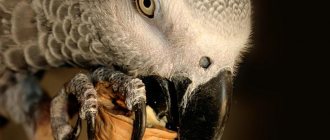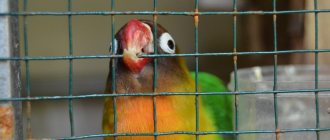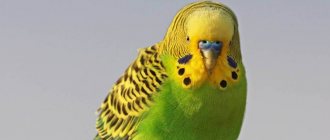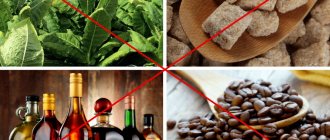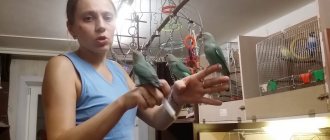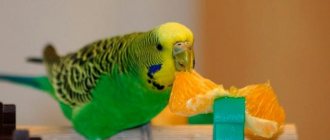Feeding a parrot can be a fun task if you know what you're doing. We all love to watch our pets eat.
There are many foods that you can feed your parrot, and equally, there are many foods that are dangerous for your bird. Knowing what food to feed and what not to feed is key to keeping your bird healthy. Parrots can eat most fruits and vegetables, but there are some common ones, like avocados, that can be harmful to your bird. Another thing that worries most parrot owners is the issue of pesticides.
The answer is yes, parrots can eat grapes. They are safe for your parrot, but should be fed in moderation due to the high concentration of fructose in grapes. This means that you should feed your parrot grapes from time to time only as a treat and not as part of their regular diet.
Grapes are a hit with parrots. They are very sweet and high in fructose, which means these fruits can boost your bird's energy.
Controlling the amount of fructose is not the only reason you should feed grapes sparingly to your parrot. Parrots know that grapes are sweet fruits and they like them, so when you offer grapes along with other food, your bird will only extract the grapes from the mixture and not the more nutritious foods. If you are not careful, this can lead to serious vitamin deficiencies.
Are grape seeds safe for a parrot?
Yes. You can feed your parrot grape seeds without causing any problems. The seeds of these fruits are rich in beneficial nutrients and antioxidants. Therefore, when cutting grapes for poultry, do not forget to put the seeds in the bowl.
If your parrot is still small, be sure to cut the grapes into small pieces before serving. Also, be sure to remove the seeds before feeding them to young parrots because their digestive systems may not be developed enough to break down grape seeds.
Your parrot will also enjoy playing with grape seeds.
Is it possible to give
In the wild, that is, in the Australian savannas, the bird feeds on cereals, tree leaves, herbs and fruits and vegetables. For domesticated pets, the daily diet should be as close to natural as possible.
The base is grain feed: millet, oats, buckwheat, wheat, etc. It should be about 70-80% of the total volume of all food served. The rest is fruits, berries, vegetables. Grapes are one of these additives.
Winemaking is widespread in Australia. Farmers grow both sweet and tart varieties of berries: shiraz, grenache, chardonnay, sauvignon, etc. Birds and budgies in particular are not averse to eating delicious grapes.
With bones
Many people mistakenly believe that grape seeds are garbage that needs to be disposed of. In fact, these so-called wastes contain a number of elements useful to the bird’s body. The proanthocyanidins contained in the seeds have anti-inflammatory and soothing properties, which helps with stomach problems.
Moreover, grape seeds help strengthen the parrot's immune system. Therefore, during the molting period, when the animal is especially weakened, ornithologists recommend mixing bones into your pet’s food. In addition to proanthocyanidins, the set includes vitamins A, E and K, which strengthen the body’s cells.
Kishmish
Considering that a fresh product spoils quite quickly, many people look towards sultanas, that is, dried seedless berries. When drying, some of the useful elements are lost, but the residual set is still impressive.
Kishmish contains:
- pectins;
- sucrose;
- essential oils;
- folic acid;
- vitamins A, B, C and PP;
- organic acids.
Dried grapes are characterized by increased energy value in contrast to the fresh product, so the daily dosage of sultanas should be reduced.
Is it possible to feed a parrot grape skins?
Typically, grape skins are not harmful to parrots. However, I must mention that grapes are classified as one of the most contaminated fruits on the market. According to a recent study, 99% of grapes contained pesticides, and a third of them were at critical levels of pesticide contamination, above what is considered fit for poultry or human consumption. Although the study was conducted in Europe, it is safe to assume that the results may be more or less the same for the rest of the world.
How to train a parrot to eat fruits and vegetables
There are several ways to accustom your wavy to new foods:
Place your budgerigar's usual food in a small plate and place it at the bottom of the cage. Feed the parrot this way for several days, and then place a slice of the prepared new product in the container.
Make some puree from the fruit you want to introduce into your diet. It needs to be mixed with grain feed and placed in a feeder. When the bird gets used to the new taste, the amount of puree can be increased, and then you can even start adding chopped pieces.
You can make “beads” from a vegetable or fruit and hang them inside the cage. While playing with them, the parrot will be able to experience a new taste. “Beads” can be alternated with wooden buttons.
Is it possible to feed a parrot grape leaves and vines?
Vine leaves and vines are also safe for parrots. If you have a grapevine in your garden, you can feed your parrot more than just the fruits of this plant.
Take a few pieces of vine and offer them to your parrot to chew on. However, the vines should be free of toxins, harmful dirt or rot. Do not feed the vine to your parrot if it has ever been treated with pesticides.
Wash the vines in hot water with a little dishwashing liquid. Scrape everything off the surface, including bird droppings and insects. Allow the vines to dry in the sun before feeding your parrot.
Grapevines are an excellent source of essential nutrients such as vitamin E, vitamin C and iron, which are an excellent source of dietary fiber.
For this reason, even if the skins are harmless, it is recommended to remove them from the grapes before giving them to your parrot to avoid pesticide poisoning.
What other fruits can birds eat?
You can diversify the bird’s diet with other berries and fruits; fortunately, the budgie’s gastrointestinal tract is not as picky as that of other exotic birds. The main thing is that everything should be in moderation. An excess of vitamins and minerals is just as harmful as a lack of them.
Berries and fruits that are beneficial for budgies:
- banana;
- raspberries;
- apricot;
- pear;
- peach;
- plum;
- apple;
- melon;
- orange;
- gooseberry.
Astringent persimmons, potatoes in any form, avocado and mango with papaya are contraindicated for birds. Garlic, herbs and alcohol should also be excluded. When preparing mixtures, do not use sugar and salt.
What can grapes do to parrots?
Grapes are rich in a variety of nutrients and vitamins and are perhaps one of the healthiest supplements you can include in your parrot's diet. Grapes are also known to have anti-cancer properties.
Below are a few ways grapes can benefit your parrot:
Boosts the parrot's immunity
The resveratrol in red grapefruits may work with vitamin D to boost the activity of a gene responsible for improving immune function.
Regulates your parrot's blood pressure
Grapes are rich in potassium, which lowers blood pressure by controlling the negative effects of salt.
Antioxidants
Grapes are also rich in a wide range of antioxidants, such as polyphenols and carotenoids, which help fight certain types of cancer while promoting heart health. Resveratrol, also found in grapes, is known to suppress the production of free radicals. Grape seeds and skins contain the most antioxidants, so be sure to feed your parrot everything.
Boosts your parrot's eye health
Grapes produce high levels of protective proteins and fewer inflammatory proteins in the retina, the area of the eyes where the photoreceptor cells that respond to light are located.
Improve your parrot's heart health
Resveratrol in grapes helps protect the heart. The high levels of antioxidants in grapes help suppress atherosclerosis (hardening of the arteries). In addition, polyphenols improve heart health by increasing HDL levels and reducing inflammation in poultry. Potassium helps maintain normal blood pressure levels by ensuring smooth blood flow, preventing the risk of heart disease.
Keep your parrot well hydrated
The high potassium content in grapes along with the low sodium levels helps maintain a good electrolyte balance in the body and flush out excess water and other toxins.
Anti-cancer properties
High levels of anthocyanins, stilbenes, flavonoids and other types of antioxidants, especially in dark grapes, help reduce the risk of certain types of cancer. However, most cancers and tumors in parrots are easily treatable.
Healthy vegetables for birds
Vegetables are allowed to be added as complementary food to budgies from their very birth. The fruits must be washed well beforehand and given in small portions.
Hot and sweet peppers
Sweet peppers contain iodine, potassium, and sodium. All these microelements are necessary for the normal functioning of the bird. Two pieces with seeds are enough for a parrot per day.
Pepper is also beneficial for your budgie.
Know! Giving your pet hot peppers is strictly prohibited.
Swede
Rutabaga contains iron and potassium, which have a good effect on the parrot's blood formation. It can be given daily. There is no need to peel the vegetable. The daily norm is 30-40 g.
Beet
This vegetable is a rich source of fiber and microelements, therefore it has a good effect on the digestion process. It should be given in slices of 20 g.
Beets can accumulate large amounts of nitrates, so I recommend blanching them first. Finely chopped tops can also be introduced into a parrot's diet.
How to train a parrot to eat vegetables and fruits. How to teach a parrot to eat sap. Part 1
Cabbage
You can use both cauliflower and broccoli. They contain all the microelements necessary for the life of wavy fish. First, pour boiling water over the inflorescences for 5 minutes. I also recommend grating the stalk and giving it to the parrot in a small amount, mixing it with grains or porridge.
Turnip
This rhizome contains folic acid, which normalizes the process of hematopoiesis. The daily norm for a wavy parrot is 30 g. Before giving pieces of turnip to a parrot, it must be blanched.
Potato
The tubers contain starch, which is difficult to digest, as well as solanine, a toxic substance, so it is not advisable to give it to a parrot as complementary food.
Vegetables for parrots
Tomatoes
Tomato is an antioxidant. It strengthens the immune system and has a bactericidal effect. Only ripe fruits are suitable for a parrot. There is no need to peel the tomato. It needs to be chopped and added to the grain feed along with the seeds.
cucumbers
If the cucumber is fresh, it contains vitamin E and a lot of water, which your pet needs to avoid dehydration. There is no need to process or peel the vegetable. Daily norm – 40-60 g.
Carrot
Carrots, as well as their tops, contain carotene, a rich vitamin complex and iron. They strengthen the cardiovascular system. Give to pets in grated form. I recommend mixing it with boiled yolk or cottage cheese.
Celery greens
Celery root itself is oversaturated with essential oils, so it is prohibited for feeding a parrot. However, its tops contain macroelements that improve the digestive process. Greens need to be cut and added to the main feed.
Fruits and berries for parrots
Can grapes be fatal to parrots?
Although grapes are generally safe for parrots, the concern comes from the way they were grown and produced. Many farmers spray their grapes with enough pesticides and chemicals to kill your parrot instantly. Today, even organic grapes can be dangerous to feed your parrot due to inadequate regulations regarding the use of the word "organic" on food labels.
But again, this is a problem that affects all other fruits and vegetables. Almost all fruits and vegetables are sprayed with pesticides, so before feeding grapes to your parrot, we advise you to wash them thoroughly to remove any traces of pesticides from the fruit skin.
But that doesn't mean you shouldn't trust the word "organic" on a grape label. An “organic” product can mean that the product contains more than 2,200 different USDA-certified organic pesticides, provided that said pesticides are made from compounds produced in nature.
How to give grapes to parrots
The berries must be whole, clean, and grown without the use of large amounts of chemicals. Buying grapes for a parrot in the cold season is not the best idea, since such a product is oversaturated with dangerous substances that increase the shelf life. Any fruits, berries and vegetables are given to the bird only after it has consumed the required amount of grain feed.
Grapes can be offered as a reward or as an addition to the main diet several times a week. This sequence should be followed for the reason that store-bought food is not full of flavor, but the bird needs it for normal metabolism and as a source of protein. If the parrot eats the grapes first, then it will refuse the grain. As a result, after some time the pet will have health problems.
Important! The bird may be frightened by dark-colored grapes, so it is a good idea to remove the skins.
The parrot does not want to eat fruit: what is the reason
Our birds are big conservatives, so they prefer to eat only familiar foods. If you have acquired an adult and she refuses fruit, then most likely she did not have fruit in her diet before. As a rule, birds living with commercial breeders eat only cheap grain feed.
However, if your parrot refuses a particular fruit or vegetable, you should offer him an alternative. The main thing is that the products are similar in composition.
Parrot nutrition part 7. What can and cannot be given to a budgie

